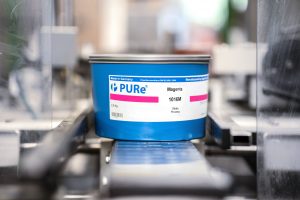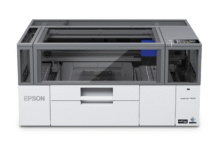Heidelberger Druckmaschinen AG (Heidelberg) and PURe inks Europe GmbH (PURe) have signed a Europe-wide cooperation agreement in order to make offset printing more sustainable. Heidelberg is committed to guiding and supporting its customers to more sustainable print production. While the use of conventional offset inks or alternatively UV curing inks often makes the introduction of sustainable print production challenging, PURe inks allow packaging and commercial printers a more sustainable production.
Heidelberg will offer these inks under the PURe label, next to its own Saphira consumables that will be part of the PURe package and will offer customers an individual implementation and transition service for the application of PURe inks. Amongst others, Heidelberg can also offer job and system analysis, operator and sales training in order to enable the customer to successfully commercialize the environmental advantages of PURe inks.

Hans Huyghe, head of Product Management Consumables at Heidelberg, “Heidelberg is happy to extend its portfolio with low-migration inks from PURe, which combine the advantages of conventional and UV drying inks. With our project approach, we enable our customers to integrate PURe as a system as part of their long term sustainability strategy.” Michael Berz, chief executive officer of PURe ink systems AG, “We have worked for several years to achieve the high-quality standard we now have with PURe. After joint testing, Heidelberg offers a complete PURe package, which is key to the European success of this novel technology. With the go-to-market through Heidelberg, we can now leverage the potential of the Heidelberg network and its application know-how to introduce PURe to all customers. Thus, we help our industry to reach its sustainability goals.”
Response to higher demand for more sustainability in print production
The innovative PURe ink system is a response to higher demand for more sustainability in print production. The new formulation is 100% free from mineral, palm, soy or coconut oil, metal driers, antioxidants and microplastics, is odor free and comes with excellent deinking results. It meets the highest standards for environment, health and labor safety. In addition, the majority of the ingredients are derived from renewable raw materials without further chemical modification or synthesis. PURe thus sets a new benchmark for offset ink sustainability.
PURe meets the criteria of all major eco-labels (i.e., EU ecolabel, nordic ecolabelling, Austrian ecolabel UZ24, blauer engel UZ195) and has received a c2c Certified Material Health Certificate at the platinum level. Thanks to its unique drying mechanism, the ink dries quickly and at a significantly lower temperature than usual contributing to higher energy efficiency. PURe inks are ideally suited for printing on food packaging materials as well as on commercial print products.
The way to more sustainability and reaching eco-labels however is more than just changing the ink tin. Instead, it requires a holistic customer-specific approach in the print shop environment covering job structure and value chain analysis and potential changes in equipment settings, consumables and even operator qualification.
















